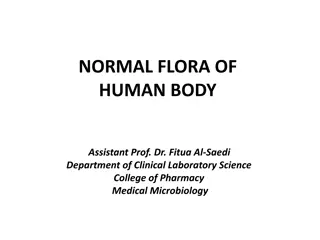Normal Flora of Human Body
Normal flora, comprising bacteria and fungi, are beneficial residents of specific body sites like the skin, colon, and vagina. These organisms, known as commensals, play a vital role in maintaining a healthy microbial balance. The internal organs are usually sterile, while different types of normal
2 views • 16 slides
Understanding Parasitism in Medical Parasitology by Prof. Dr. Ahmed Ali Mohammed
Prof. Dr. Ahmed Ali Mohammed delves into the intriguing world of parasitism, exploring the complex relationships between parasites and hosts. He explains the various types of relationships in parasitology, such as symbiosis, mutualism, commensalism, and parasitism, shedding light on how parasites in
0 views • 23 slides
Understanding Bacteria: General Characteristics and Economic Importance
Bacteria are ubiquitous microorganisms found in various environments, with some living as commensals or symbionts while others causing diseases. They are characterized by their small size, absence of a nucleus, and diverse classifications such as prokaryotes, eukaryotes, cyanobacteria, and archaebac
0 views • 15 slides
Overview of Neisseria: Morphology, Cultural Characteristics, and Pathogenicity
Neisseria, named after Dr. Albert Neisser, are gram-negative cocci known for causing gonorrhoea and other infections. They are aerobic, catalase-positive organisms usually found as commensals in the upper respiratory tract. Neisseria gonorrhoeae and Neisseria meningitidis are the most significant sp
0 views • 8 slides



